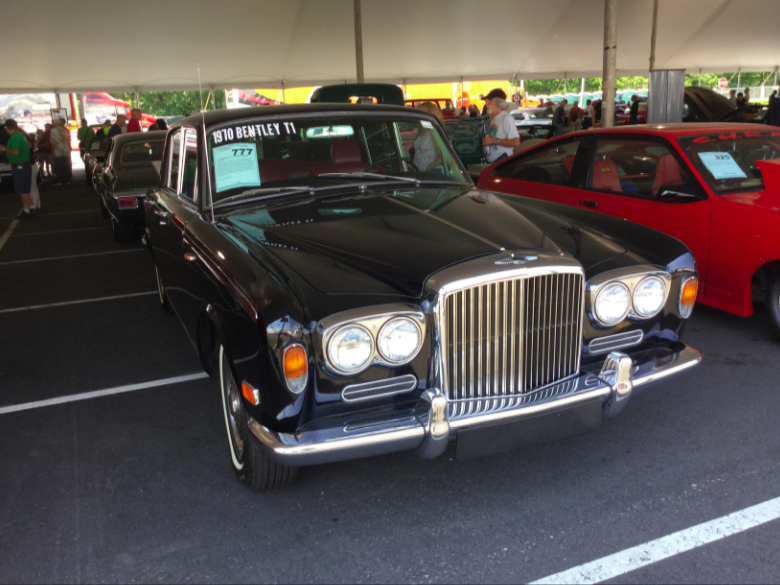-
Insurance
InsuranceAbout our productsLearn about insuringGet a quote Get current values, historical values, model history and more.
-
Valuation
ValuationHagerty valuation toolLook up a vehicle value Get current values, historical values, model history and more.
-
Events
EventsHagerty official eventsHagerty ClubhouseEvent calendar
-
Entertainment
EntertainmentMore to explore
- Portal login
1971 Bentley T1
Base Saloon 6.8 L
Vehicle values by condition
Fair
Condition 4
£7,500
#4 cars are daily drivers, with flaws visible to the naked eye. The chrome might have pitting or scratches, the windshield might be chipped.
Good
Condition 3
£11,100
#3 cars could possess some, but not all of the issues of a #4 car, but they will be balanced by other factors such as a fresh paint job or a new, correct interior.
Excellent
Condition 2
£21,600
#2 cars could win a local or regional show. They can be former #1 cars that have been driven or have aged. Seasoned observers will have to look closely for flaws.
Concours
Condition 1
£39,500
#1 vehicles are the best in the world. The visual image is of the best car, unmodified, in the right colours, driving onto the lawn at the finest concours.
Insurance premium for a
1971 Bentley T1 Base Saloon 6750
valued at £11,100
£128.69
/ year*
History of the 1965 - 1977 Bentley T1

1965 - 1977 Bentley T1
Rolls-Royce contemplated a monocoque design as early as 1957, in an effort to modernize the company’s product line, but the existing factory-bodied Silver Cloud was more economical to build and was selling in large numbers, so the Shadow wasn’t launched until late 1965. The model, along with its Bentley T1 twin, was the first Rolls-Royce to employ a monocoque construction.
The Bentley T1 was a drastic change from the S3 that preceded it. It was smaller, square, and unprepossessing. In all, just over 1,800 units were produced, including nine long-wheelbase models, 115 coupes (of which one was from Pininfarina), and 41 convertibles. The remainder were standard steel saloons.
The T1 was lighter, faster, and better handling than preceding Bentleys, but the car didn’t possess the same cachet as the early models. Starting out with the 200-bhp, 6,230-cc V-8 from the Silver Cloud III, the engine was expanded to 6,750 cc in 1970. GM’s Turbo-Hydramatic 350 three-speed automatic transmission was standard, except for the overseas models that got the Turbo-Hydramatic 400. Power windows and four-wheel disc brakes were standard, and the rear suspension was self-levelling, based on the Citroen DS19 hydraulic/hydrogen sphere system.
As one might expect, the finish on the new cars was exemplary, with Connolly leather interior, lambs-wool carpet, walnut dash and door trims, with full instrumentation. Mileage was in the “if you have to ask” category, at about 10-12 mpg.
In 1977, Bentley introduced the T2 (and the twin Rolls-Royce Silver Shadow II), which was essentially a T1 with rack-and-pinion steering, minor bumper differences, and a slightly firmer front suspension. The car cost nearly $85,000 new and remained in production until 1980, at which point it was replaced by the Bentley Mulsanne.
As good as the Bentley T-Types were, production numbers were relatively high for the Crewe company (nearly 2,400 in all). Furthermore, as the cars transitioned from being the height of modern luxury to yesterday’s news, values plummeted and maintenance was often deferred. Repair costs of forsaken T1s soon surpassed their retail value, and many of the first series cars suffered. Popular wisdom advises that “the wrong car can be a bad deal free,” so it is important that prospective owners understand Bentley T-Type repair costs before writing a cheque, and then only doing so after locating the best example possible.
Areas of particularly expensive concern include the complex brake system, the convoluted Citroen-designed rear suspension, and rust in general. Right-hand-drive cars often came to the U.S. after failing an MOT, and should be approached with caution. Beware vehicles with wedding service history; only consider cars with complete maintenance and ownership documents, preferably from the original owner.
Hagerty Newsletter
Get your weekly dose of car news from Hagerty UK in your inbox

ADVERTISEMENT